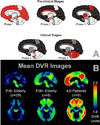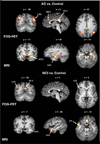Neuroimaging markers for the prediction and early diagnosis of Alzheimer's disease dementia
- PMID: 21696834
- PMCID: PMC3275347
- DOI: 10.1016/j.tins.2011.05.005
Neuroimaging markers for the prediction and early diagnosis of Alzheimer's disease dementia
Abstract
Alzheimer's disease (AD) is a progressive age-related neurodegenerative disease. At the time of clinical manifestation of dementia, significant irreversible brain damage is already present, rendering the diagnosis of AD at early stages of the disease an urgent prerequisite for therapeutic treatment to halt, or at least slow, disease progression. In this review, we discuss various neuroimaging measures that are proving to have potential value as biomarkers of AD pathology for the detection and prediction of AD before the onset of dementia. Recent studies that have identified AD-like structural and functional brain changes in elderly people who are cognitively within the normal range or who have mild cognitive impairment (MCI) are discussed. A dynamic sequence model of changes that occur in neuroimaging markers during the different disease stages is presented and the predictive value of multimodal neuroimaging for AD dementia is considered.
Published by Elsevier Ltd.
Figures



References
-
- Ott A, et al. Incidence and risk of dementia. The Rotterdam Study. Am J Epidemiol. 1998;147:574–580. - PubMed
-
- Dubois B, et al. Research criteria for the diagnosis of Alzheimer's disease: revising the NINCDS-ADRDA criteria. Lancet neurology. 2007;6:734–746. - PubMed
-
- Dubois B, et al. Revising the definition of Alzheimer's disease: a new lexicon. Lancet Neurol. 2010;9:1118–1127. - PubMed
-
- Pastor P, and Goate AM. Molecular genetics of Alzheimer's disease. Curr Psychiatry Rep. 2004;6:125–133. - PubMed
Publication types
MeSH terms
Substances
Grants and funding
- R01 AG010897/AG/NIA NIH HHS/United States
- R01AG027435/AG/NIA NIH HHS/United States
- R01 AG027435/AG/NIA NIH HHS/United States
- R37 AG025516/AG/NIA NIH HHS/United States
- P41 RR023953/RR/NCRR NIH HHS/United States
- P50 AG005133/AG/NIA NIH HHS/United States
- RF1 AG025516/AG/NIA NIH HHS/United States
- P01 AG025204/AG/NIA NIH HHS/United States
- P41RR023953/RR/NCRR NIH HHS/United States
- P01 AG036694/AG/NIA NIH HHS/United States
- U01 AG024904/AG/NIA NIH HHS/United States
- U01AG024904/AG/NIA NIH HHS/United States
- R01AG10897/AG/NIA NIH HHS/United States
LinkOut - more resources
Full Text Sources
Other Literature Sources
Medical

